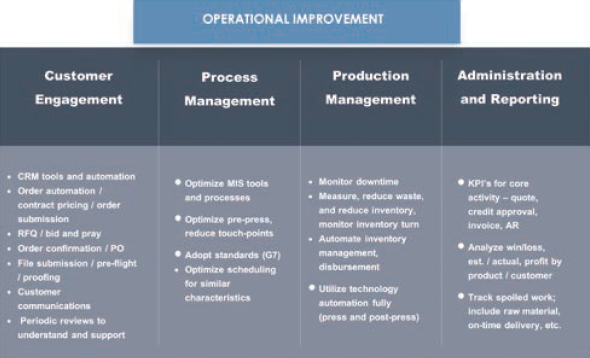
Features
Business
Management
Opinion
Do more with less
The dos and don’ts of operational-level SWOT analysis
May 31, 2021 By Bob Dale and Howard Conway
 A list of key productivity indicators to track. Image courtesy Bob Dale
A list of key productivity indicators to track. Image courtesy Bob Dale The pandemic has forced all companies to make major changes. A February 2021 study by PRINTING United Alliance indicated that 79 per cent of print service providers have seen a 26 per cent decrease in year-over-year volume in 2020. If your company had a diversified product mix, you may have been able to mitigate the impact, but many organizations had to reduce staff. Even when the volume of business began to increase, as COVID-19 cases declined in fall 2020, many owners were reluctant to re-staff to pre-pandemic levels. As a result, the existing staff are now expected to do more. In these times, operational efficiency is very critical. However, there are many aspects to ‘operational efficiency,’ including digital, production and administrative workflows.
Before investing in a new ERP, e-commerce, MIS or prepress software, please note the utilization of existing software, tools and talent can be improved or enhanced. Therefore, it is advisable to conduct an operational-level SWOT and a preliminary cost-benefit analyses to prioritize the areas for improvement. Often, major changes are set aside until an outside influence or customer need compels the automation or process improvement. If you are only reactive, you’re likely to miss many business opportunities.
SWOT analysis
Many owners/managers are tempted to assign team members to conduct the review process. The challenge with this approach is that staff are typically busy with client orders and may not have the time required for process improvement.
As reported in the November 2020 column, Richard Kouwenhoven, CEO of Hemlock Printing in B.C., identified that implementing major operational changes requires hands-on involvement and excellent communications company-wide, starting with engagement of the senior leadership team.
Change and continuous improvement requires that the people have the right tools to succeed. If this is to be managed by internal resources, then staff need:
- an understanding of company objectives and benefits;
- knowledge of how to evaluate and document workflow using tolls like Kaizen;
- have the authority and time to conduct a full investigation;
- support from colleagues to review progress as well as for guidance purposes;
- training on how to plan, document, implement and monitor change that will result in positive improvements; and
- reward and recognition.
If the internal team members are working diligently to manage the current volume of work, then including additional projects will risk current customer satisfaction, errors, cause burnout or delay achieving success. It may be appropriate to hire outside help and expertise to manage the process.
Hiring experts
To undertake more extensive changes, such as implementing digital storefront, digital automation requiring coding or deep technical expertise and outsourcing elements of the business, it would be best to hire subject matter experts. It is important to set realistic expectations. I’ve inherited many change initiatives that were started with unrealistic expectations. We did manage to accomplish the goals, but faced ongoing challenges with helping senior management understand the full scope of the transition. Good luck with your initiatives, and remember seeking help is better than failing.
Bob Dale and Howard Conway are with Connecting for Results Inc. They can be reached via e-mail at info@connectingforresults.com.
This article originally appeared in the April 2021 issue of PrintAction.
Print this page